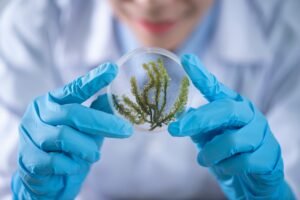
The contributions of women in science have been long overlooked and underappreciated. From the mathematician Katherine Johnson, whose calculations were pivotal to space exploration, to Rosalind Franklin, whose work on X-ray crystallography was crucial to our understanding of DNA structure, women have made significant strides in scientific research. Today, we celebrate these unsung heroes who broke barriers and defied stereotypes with their groundbreaking discoveries and remarkable achievements. Join us as we shine a spotlight on some of the most prominent female scientists who have changed the face of science forever!
It is time celebrating Women in Science.
Introduction: Celebrating Women in Science
The contributions of women in science have been largely hidden throughout history. In recent years, however, there has been a shift towards celebrating the accomplishments of women in science. This is evident in the popularity of books and movies such as Hidden Figures, which tells the story of African American women working at NASA during the Space Race.
There are many reasons to celebrate women in science. For one, they have made significant contributions to our understanding of the world around us. Women like Marie Curie and Rosalind Franklin played key roles in the development of modern physics and chemistry. More recently, women like Jane Goodall and Sylvia Earle have helped us to better understand the natural world.
Secondly, women in science are often trailblazers, breaking down barriers that have prevented others from achieving success. One example is astronaut Mae Jemison, who was the first African American woman to travel into space. Another is Barbara McClintock, who won a Nobel Prize in Physiology or Medicine for her discoveries about genetics.
Women in science serve as role models for young girls and women everywhere. They show that it is possible to achieve success in male-dominated fields such as mathematics, engineering, and physics. When girls and young women see other women succeeding in these fields, they are more likely to believe that they can do it too.
So let’s take a moment to celebrate the accomplishments of all the incredible women who have made contributions to science!
History of Women in Science
Since the dawn of civilization, women have played a vital role in the field of science. One of the earliest known female scientists was Hypatia of Alexandria, a Greek philosopher and mathematician who lived in the 4th century AD. While her work was largely overshadowed by that of her male counterparts, she is now considered one of the most important thinkers of her time.
Throughout history, there have been many other notable women in science, including Marie Curie, Rosalind Franklin, and Jane Goodall. In recent years, women have made great strides in the field of science, with more girls than ever before studying STEM subjects (science, technology, engineering, and math) in school and going on to pursue careers in these fields.
Despite these advances, women still face significant challenges in the world of science. They are often underrepresented in leadership positions and face discrimination both inside and outside of academia. But with more women than ever before dedicated to making their mark on the field of science, it’s only a matter of time until they achieve true equality.
Significant Female Scientists
In celebration of Women’s History Month, we’re highlighting some significant female scientists who have made important contributions to their field. These women have helped pave the way for other women in science and continue to be an inspiration to us all.
Marie Curie was a Polish physicist and chemist who is best known for her work on radioactivity. She was the first woman to win a Nobel Prize and is one of only four people to have won two Nobel Prizes.
Rosalind Franklin was a British chemist who made major contributions to the understanding of DNA structure and function. Her work played a key role in the discovery of the double helix structure of DNA.
Grace Hopper was an American computer scientist and United States Navy rear admiral. She was one of the first programmers of the Harvard Mark I computer and developed the first compiler for a computer programming language.
Sally Ride was an American astronaut and physicist. She became the first American woman in space when she flew aboard the Space Shuttle Challenger in 1983.
These are just a few of the many incredible women who have made significant contributions to science. We hope their stories inspire you to pursue your own scientific ambitions!
Barriers to Female Scientists
Women scientists have come a long way since the days of being hidden figures in research laboratories. However, they continue to face many barriers that prevent them from achieving prominence in their field. Some of these barriers include:
-The gender pay gap: Women scientists earn an average of 21% less than their male counterparts, making it difficult to progress in their careers.
-Lack of flexible working arrangements: Many women scientists have caring responsibilities at home, which makes it difficult to commit to long hours and inflexible working patterns.
-Sexual harassment and discrimination: Unfortunately, sexual harassment and discrimination are still commonplace in many scientific workplaces. This can make it very difficult for women to feel comfortable and safe in their work environment.
-Imposter syndrome: Many women scientists suffer from imposter syndrome, which is the belief that they are not good enough or capable of doing their job. This can lead to self-doubt and a lack of confidence, both of which can be career-limiting factors.
Strategies to Increase Opportunities for Female Scientists

In recent years, there has been a surge in public interest in the stories of female scientists who have made significant contributions to their fields. Celebrating Women in Science will be motivating for aspiring females. This renewed interest has led to increased opportunities for women scientists to be recognized for their work. Here are a few strategies that can help increase opportunities for female scientists:
1. Make an effort to seek out and highlight the accomplishments of women scientists in the media.
2. Advocate for more women scientists to be given speaking roles at conferences and other public events.
3. Encourage young girls and women to pursue careers in science through mentorship and outreach programs.
4. Support initiatives that aim to increase the number of women in leadership positions within scientific organizations.
5. Help create a more inclusive environment within the scientific community by promoting understanding and respect for the diversity of perspectives and experiences that women bring to the table.
Conclusion: The Impact of Women in Science
In recent years, there has been a push to increase the representation of women in science. This is due in part to the realisation that women have been historically underrepresented in the field, as well as the acknowledgement of the valuable perspectives and contributions that women can bring to science.
There are many ways in which women have made an impact in science. One is through their research contributions. Women scientists have made groundbreaking discoveries in a wide range of fields, from medicine to astrophysics. They have also contributed to our understanding of important issues such as climate change and gender equality.
Women have also played an important role in advancing science education and public engagement. In recent years, there has been a growing movement of women scientists who are using social media and other platforms to communicate their work to a wider audience. These efforts are helping to increase the visibility of women in science and inspire more girls and young women to pursue careers in STEM fields.
The impact of women in science cannot be underestimated. They are making vital contributions to our understanding of the world around us and shaping the future of science itself







